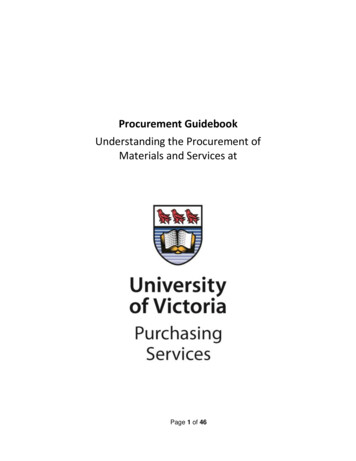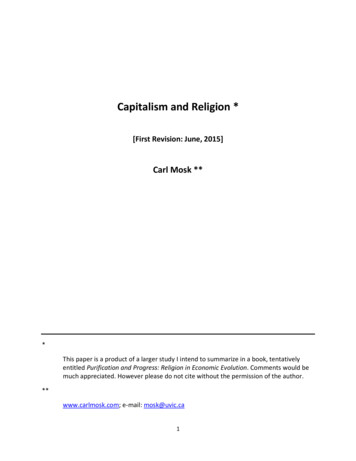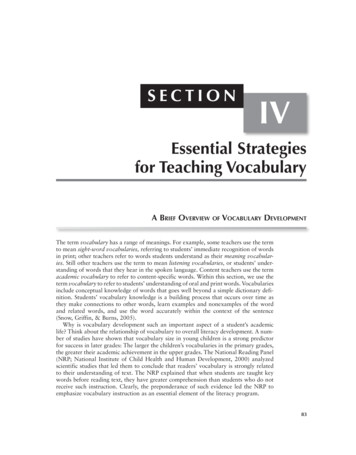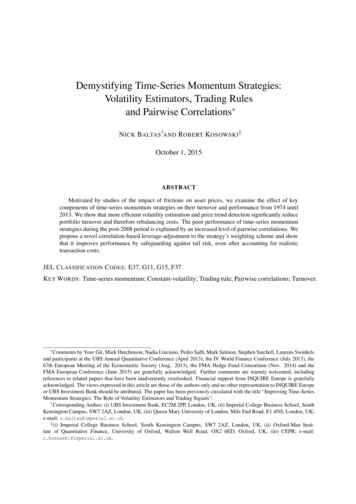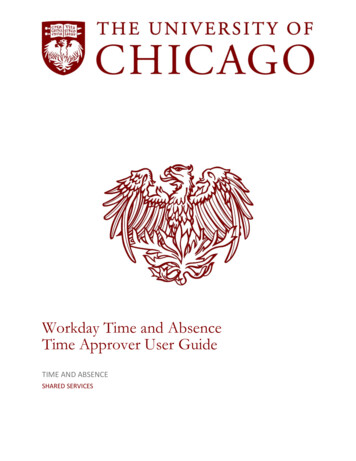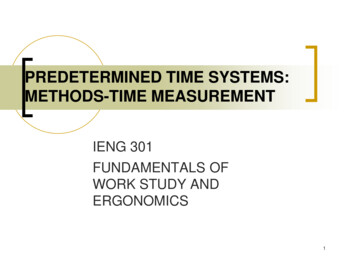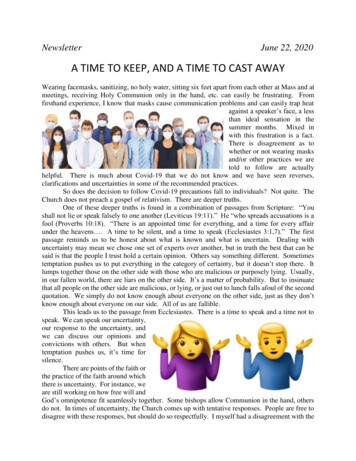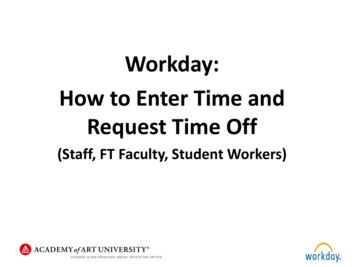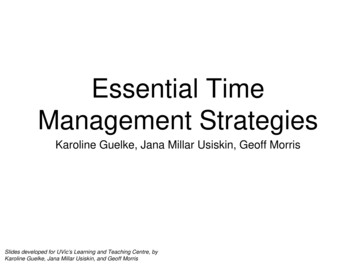
Transcription
Essential TimeManagement StrategiesKaroline Guelke, Jana Millar Usiskin, Geoff MorrisSlides developed for UVic’s Learning and Teaching Centre, byKaroline Guelke, Jana Millar Usiskin, and Geoff Morris
Outline Record keeping Breaking down big tasks Prioritizing Work rhythms Bringing it togetherSlides developed for UVic’s Learning and Teaching Centre, byKaroline Guelke, Jana Millar Usiskin, and Geoff Morris
What kind of time managementtool(s) do you use? How effective is it? What are the drawbacks?Slides developed for UVic’s Learning and Teaching Centre, byKaroline Guelke, Jana Millar Usiskin, and Geoff Morris
Record keeping Make a habit of recording all tasks that need to bedone Find a format that works and stick to it Schedule first steps of big projects early Writing down tasks helps with planning andlessens anxiety, lets you reflect on your progressSlides developed for UVic’s Learning and Teaching Centre, byKaroline Guelke, Jana Millar Usiskin, and Geoff Morris
Activity In this session we’ll try one method of designing aweekly schedule On your own list all next week’s commitments andestimate the amount of time you will need for each Discuss your commitments with another personand add any of your partner’s ideas to your ownlist if they also apply to youSlides developed for UVic’s Learning and Teaching Centre, byKaroline Guelke, Jana Millar Usiskin, and Geoff Morris
Breaking it downSlides developed for UVic’s Learning and Teaching Centre, byKaroline Guelke, Jana Millar Usiskin, and Geoff Morris
What is it aboutbig tasksthat make thembig problems?Slides developed for UVic’s Learning and Teaching Centre, byKaroline Guelke, Jana Millar Usiskin, and Geoff Morris
What is it aboutsmall tasksthat make themno problem?Slides developed for UVic’s Learning and Teaching Centre, byKaroline Guelke, Jana Millar Usiskin, and Geoff Morris
The big tasksin grad school Thesis / Dissertation Teaching / Teaching assistant work Coursework Comprehensives / Candidacies / Prospectus Research project / Research assistant work Journal articles / Conference papersSlides developed for UVic’s Learning and Teaching Centre, byKaroline Guelke, Jana Millar Usiskin, and Geoff Morris
1. Manageable-ize Break it up Delegate and remove unessential steps Plan out milestones and prioritize Check off as you go Adjust as neededSlides developed for UVic’s Learning and Teaching Centre, byKaroline Guelke, Jana Millar Usiskin, and Geoff Morris
1. Manageable-izePick two or three big tasksFor each task, Break it up Delegate and remove unessential steps Plan out milestones and begin to prioritizeSlides developed for UVic’s Learning and Teaching Centre, byKaroline Guelke, Jana Millar Usiskin, and Geoff Morris
1. Manageable-ize2. Stop worrying about the future!3. Use the right toolsSlides developed for UVic’s Learning and Teaching Centre, byKaroline Guelke, Jana Millar Usiskin, and Geoff Morris
3. Use the right tools Pen and paper Calendar AppsWhat kind of tools do you see yourself using?Slides developed for UVic’s Learning and Teaching Centre, byKaroline Guelke, Jana Millar Usiskin, and Geoff Morris
PrioritizingSlides developed for UVic’s Learning and Teaching Centre, byKaroline Guelke, Jana Millar Usiskin, and Geoff Morris
Slides developed for UVic’s Learning and Teaching Centre, byKaroline Guelke, Jana Millar Usiskin, and Geoff MorrisComic from"Piled Higher and Deeper" by Jorge Chamwww.phdcomics.com
Why prioritize? Your stress level diminishes (you don’t endanger other drivers) You don’t get insomnia you are more productive You can enjoy your break time more You eliminate the “decision dilemma”—“What do I do next?” For every 1 minute you spend in planning, you will gain 10 inexecution 1 minute 10 minutes. 10 minutes 1 hour and 40 minutesThe difference between being REACTIVE and PROACTIVE when you don’t plan, you end up responding to the day’s trivial, time-consumingevents as they occurSlides developed for UVic’s Learning and Teaching Centre, byKaroline Guelke, Jana Millar Usiskin, and Geoff MorrisMaterials adapted from “The Importance of Planning andPrioritizing,” by Laura Stack
Methods Scaling from 1-10 ABC Analysis Steven Covey’s Four QuadrantsSlides developed for UVic’s Learning and Teaching Centre, byKaroline Guelke, Jana Millar Usiskin, and Geoff Morris
List of Tasks grocery shopping prepare slides for LTC workshop on Time Management prepare midterm exam questions for English 135 prepare lesson plan for English 135 class dance class research Virginia Woolf and communication technology for MLA 2016 paper write 500 words for MLA paper meet with BM to discuss big data methodology for MLA paperSlides developed for UVic’s Learning and Teaching Centre, byKaroline Guelke, Jana Millar Usiskin, and Geoff Morris
Scaling from 1-10 Number your list from 1 (very important) to 10(unimportant) Use for a simple to-do-list Can be created quicklySlides developed for UVic’s Learning and Teaching Centre, byKaroline Guelke, Jana Millar Usiskin, and Geoff Morris
Scaling 1-10 grocery shopping8 prepare slides for LTC workshop on Time Management prepare midterm exam questions for English 135 prepare lesson plan for English 135 class dance class research Virginia Woolf and communication technology for MLA 2016 paper5 write 500 words for MLA paper meet with BM to discuss big data methodology for MLA paper1326Slides developed for UVic’s Learning and Teaching Centre, byKaroline Guelke, Jana Millar Usiskin, and Geoff Morris47
ABCDE Method A-level tasks (no more than 25% of your time) B-level tasks everything else — busy work, wants (as opposed to needs), nice to haves, and goofing off(95% of what you do online)activities that have no penalty if not completed on timeD-level tasks everything you have to do to meet your short- and long-term academic and career goalsactivities that may have a mildly negative consequence if not completed on timeC-level tasks critical thingsthings that will lead to significant consequences if not done on time — focusing onconsequences creates an urgency factorDelegate — these are actions that someone else can take onE-level tasks Tasks that could be Eliminated if necessarySlides developed for UVic’s Learning and Teaching Centre, byKaroline Guelke, Jana Millar Usiskin, and Geoff Morris
ABCDE Method grocery shoppingD prepare slides for LTC workshop on Time Management prepare midterm exam questions for English 135 prepare lesson plan for English 135 class dance class research Virginia Woolf and communication technology for MLA 2016 paperB write 500 words for MLA paper meet with BM to discuss big data methodology for MLA paperABACSlides developed for UVic’s Learning and Teaching Centre, byKaroline Guelke, Jana Millar Usiskin, and Geoff MorrisBC/E
Steven Covey’s FourQuadrants Create a grid that classifies your tasks according totheir level of urgency and importance Try to ensure important work is done before itbecomes urgentSlides developed for UVic’s Learning and Teaching Centre, byKaroline Guelke, Jana Millar Usiskin, and Geoff MorrisMaterial adapted from The 7 Habits of Highly Effective People:Powerful Lessons in Personal Change by Steven Covey
Steven Covey’s FourQuadrantsUrgentImportantNot ImportantNot Urgent- slides for workshop- lesson plan for English- research for MLA paper- prepare midterm examquestions- dance class- grocery shopping- practice pianoSlides developed for UVic’s Learning and Teaching Centre, byKaroline Guelke, Jana Millar Usiskin, and Geoff MorrisMaterial adapted from The 7 Habits of Highly Effective People:Powerful Lessons in Personal Change by Steven Covey
Activity: Prioritizing Using one of the three methods discussed,prioritize the tasks you’ve listedSlides developed for UVic’s Learning and Teaching Centre, byKaroline Guelke, Jana Millar Usiskin, and Geoff Morris
ABCDE Method A-level tasks (no more than 25% of your time) B-level tasks everything else — busy work, wants (as opposed to needs), nice to haves, and goofing off(95% of what you do online)activities that have no penalty if not completed on timeD-level tasks everything you have to do to meet your short- and long-term academic and career goalsactivities that may have a mildly negative consequence if not completed on timeC-level tasks critical thingsthings that will lead to significant consequences if not done on time — focusing onconsequences creates an urgency factorDelegate — these are actions that someone else can take onE-level tasks Tasks that could be Eliminated if necessarySlides developed for UVic’s Learning and Teaching Centre, byKaroline Guelke, Jana Millar Usiskin, and Geoff Morris
Personal Work Rhythms Individual times of higher/lower efficiency (i.e.morning versus evening) Activity: identify your prime productiveperiod(s), then share with another person anddiscuss: How is your partner’s work rhythm different fromyours? Have you ever considered your natural workrhythm in your scheduling? Has this helped?When schedule allows, consider personal rhythmfor maximum efficiencySlides developed for UVic’s Learning and Teaching Centre, byKaroline Guelke, Jana Millar Usiskin, and Geoff Morris
Taking Breaks How do you manage your breaks? What do you liketo do? Breaks allow your brain to process and synthesizeinformation Breaks help you maintain motivation, lessen stress,and boost productivitySlides developed for UVic’s Learning and Teaching Centre, byKaroline Guelke, Jana Millar Usiskin, and Geoff MorrisMaterial adapted from University of Guelph, “A Guideto Time Management: Breaks and Rewards
Taking Breaks Schedule regular breaks, i.e. 10 min. per hour ofwork, and stick to your schedule The longer you’ve been working, the longer thebreak should be Get away from the computer and move Good activities: exercise, socializing, switching toother tasks like grocery shopping or house cleaningSlides developed for UVic’s Learning and Teaching Centre, byKaroline Guelke, Jana Millar Usiskin, and Geoff MorrisMaterial adapted from University of Guelph, “A Guide toTime Management: Breaks and Rewards
Activity: Building a ScheduleOn your schedule: add fixed time commitments (i.e. classes)mark your personal high and low productivity timesinsert your tasks, matching high-priority tasks tohigh productivity times and low priority/easier tasksto low productivity timesbriefly share with another personSlides developed for UVic’s Learning and Teaching Centre, byKaroline Guelke, Jana Millar Usiskin, and Geoff Morris
Disclaimer! We are not robots If you choose some of these strategies and usethem most of the time, your efficiency will increaseSlides developed for UVic’s Learning and Teaching Centre, byKaroline Guelke, Jana Millar Usiskin, and Geoff Morris
Review Record keeping Breaking down big tasks Prioritizing Work rhythms Bringing it togetherSlides developed for UVic’s Learning and Teaching Centre, byKaroline Guelke, Jana Millar Usiskin, and Geoff Morris
References“A Guide to Time Management: Breaks and Rewards.”University of Guelph, Learning Commons. Web.Accessed Nov. 4, 2015.Covey, Stephen. The 7 Habits of Highly EffectivePeople: Powerful Lessons in Personal Change. NewYork: Simon and Schuster, 1990.Stack, Laura. “The Importance of Planning andPrioritizing.” The Productivity Pro. 2000. Web.Accessed Nov. 5, 2015.Slides developed for UVic’s Learning and Teaching Centre, byKaroline Guelke, Jana Millar Usiskin, and Geoff Morris
weekly schedule On your own list all next week’s commitments and . Material adapted from The 7 Habits of Highly Effective People: Powerful Lessons in Personal Change by Steven Covey Slides developed for UVic’s Learning and Teaching Centre, by Karoline Guelke, Jana Millar Usiskin, and Geoff Morris. Steven Covey’s Four Quadrants . Urgent. Not Urgent. Important-slides for workshop .
